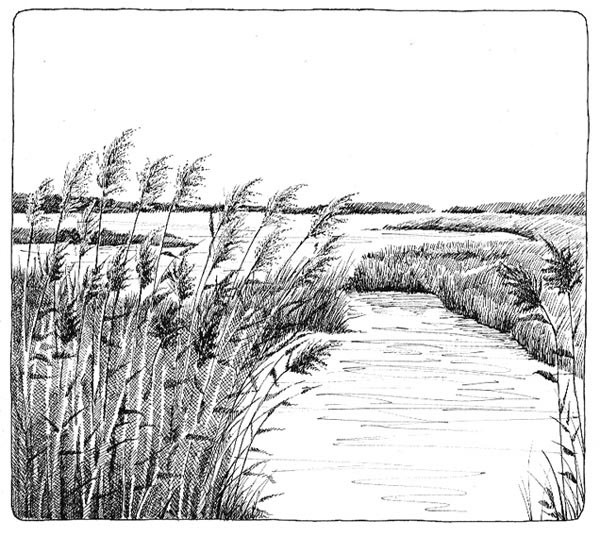
Some people call any wet, mucky place a bog, or maybe a swamp. They hardly ever think to call it a fen. It may well be a fen, of course, unless it’s a marsh. Or possibly a seep.
How to sort all this out?
First, observe the water in the wetland. Is it flowing or stagnant? If it’s flowing, you have yourself a marsh. Marshes usually occur adjacent to ponds, lakes, slow-moving rivers, or at river mouths. The constant movement of water increases the oxygen content in the water, brings an inflow of nutrients, and promotes decomposition. A fine, black muck soil develops that is high in well-decomposed organic matter. A variety of grasses and sedges thrives in marshes, including the familiar cattail. There are almost never any woody plants growing in a marsh, because they cannot grow in standing water.
There actually is a second type of wetland that has flowing water in it, though compared to a marsh, it’s usually very small: a seep. The flowing water in a seep comes from underground, where cracks in the bedrock direct flow toward the surface. A seep can persist throughout the year and often forms the headwaters of perennial streams. One feature of a seep is the constant temperature of the groundwater year-round. This allows vegetation such as grasses and sedges to get an early start in the spring, providing food for animals such as bears and deer.
If the water in your wetland is not flowing, then you don’t have a marsh or a seep, and you need to ask yourself a second question: are there woody plants growing in it? If there are, then you’re talking about a swamp. Swamps always occur in low spots in the forest that have wet soils, but not so wet that woody plants are excluded. They are only intermittently wet, during spring flooding and heavy summer storms. Swamps can be small dips in the landscape, taking up an acre or so, or they can occupy many hundreds of acres. Trees like black ash, green ash, red maple, and swamp white oak are well adapted to the seasonally wet conditions of swamps.
If your stagnant-water wetland has few or no trees growing in it, then you’re left with one of three possible choices: a bog, a fen, or a vernal pool. The vernal pool is the easiest to identify, because it’s small and only seasonally wet. Essentially, it is a swamp without trees. Vernal pools are lined with bedrock or dense gravel called hardpan, which can hold water well into the summer months. They typically lack inlets and outlets, gathering water from snowmelt and rainfall. In the spring they teem with amphibian life. Frogs and salamanders depend on them for breeding, egg-laying, and larval development. Because they dry out each year, vernal pools lack predators, such as small fish, that would normally prey on such a bounty of food.
Finally, if your wetland is wet all year, has stagnant water, and has few or no trees growing in it, you’re down to two options: a bog or a fen. Bogs are the most nutrient-poor of the wetlands. With little to no inflow or outflow, decomposition happens slowly, acids build up, and nutrients are scarce. Most of the water and minerals in a bog come from rainfall and airborne dust. Bog plants have developed creative ways to absorb nutrients. For instance, acid-loving dwarf shrubs have partnerships with fungi in their roots that make soil nutrients more available, while carnivorous pitcher plants, sundews, and bladderworts go after their food more directly, trapping and dissolving little insects. The most abundant plants in a bog are sphagnum mosses and acid-loving dwarf shrubs called heaths, including cranberries, leatherleaf, Labrador tea, and bog laurel.
Life in the fen is much easier than in a bog. Water does flow, albeit slowly and imperceptibly, flushing out the acidic byproducts of decomposition. Fens are fed by an upwelling of groundwater that is laden with calcium and other minerals. A rich fen looks like a lush, wet grassland and is dominated by sedges. Rich fens have many more species of plants and different mosses than bogs. High spots called hummocks are home to some of our native wetland shrubs like alternate-leaved buckthorn, shrubby cinquefoil, and the white-leaved hoary willow.
New England’s most famous fen was in Boston’s Back Bay, near the aptly named Fenway Park. But be careful not to identify wetlands solely by their proper names. Eshqua Bog, for example, a much-visited wetland in Hartland, Vermont, that is well known for its showy lady’s slipper orchids, is not a bog but a fen. It’s just so tempting to call everything a bog!


Discussion *